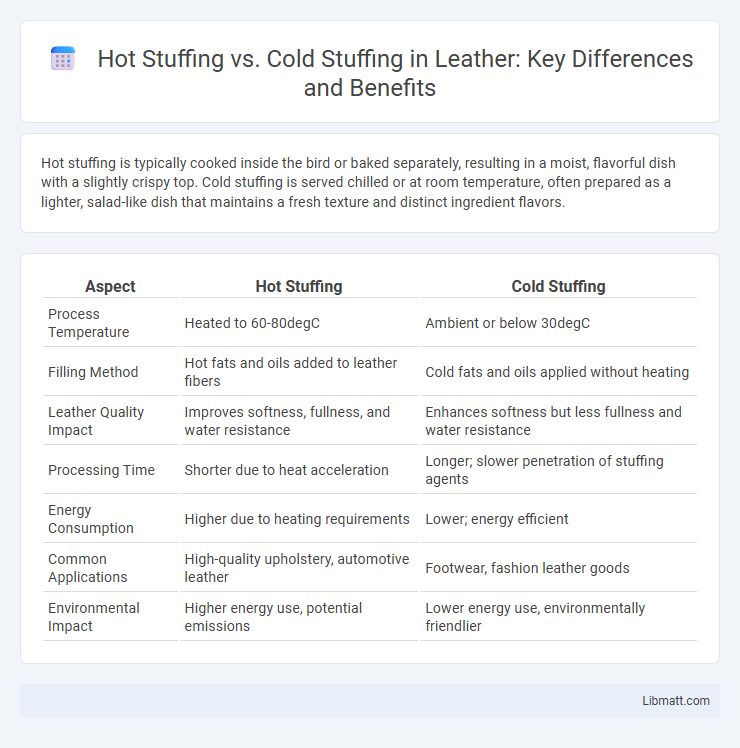Hot stuffing is typically cooked inside the bird or baked separately, resulting in a moist, flavorful dish with a slightly crispy top. Cold stuffing is served chilled or at room temperature, often prepared as a lighter, salad-like dish that maintains a fresh texture and distinct ingredient flavors.
Table of Comparison
| Aspect | Hot Stuffing | Cold Stuffing |
|---|---|---|
| Process Temperature | Heated to 60-80degC | Ambient or below 30degC |
| Filling Method | Hot fats and oils added to leather fibers | Cold fats and oils applied without heating |
| Leather Quality Impact | Improves softness, fullness, and water resistance | Enhances softness but less fullness and water resistance |
| Processing Time | Shorter due to heat acceleration | Longer; slower penetration of stuffing agents |
| Energy Consumption | Higher due to heating requirements | Lower; energy efficient |
| Common Applications | High-quality upholstery, automotive leather | Footwear, fashion leather goods |
| Environmental Impact | Higher energy use, potential emissions | Lower energy use, environmentally friendlier |
Introduction to Hot Stuffing and Cold Stuffing
Hot stuffing involves cooking the stuffing mixture inside the bird or in a separate dish at a high temperature, ensuring thorough heating that eliminates bacteria and enhances flavor integration. Cold stuffing refers to preparing the stuffing mixture separately and serving it uncooked or reheated, which can preserve distinct textures and freshness but requires careful handling to prevent contamination. Understanding the temperature and cooking methods of hot and cold stuffing is essential for food safety and desired taste outcomes.
Definition of Hot Stuffing
Hot stuffing is a mixture of bread, herbs, vegetables, and broth that is cooked inside the turkey or in a separate dish until thoroughly heated and safe to eat. This method ensures the stuffing absorbs the juices and flavors released during roasting, resulting in a moist and flavorful dish. Your choice between hot stuffing and cold stuffing depends on cooking time, safety concerns, and desired texture.
Definition of Cold Stuffing
Cold stuffing refers to a mixture of uncooked ingredients, such as bread, herbs, and seasonings, combined before being stuffed into poultry or other meats. This preparation method relies on the heat of the meat to cook the stuffing thoroughly during roasting. Cold stuffing requires careful attention to ensure food safety and achieve proper internal temperatures.
Key Differences Between Hot and Cold Stuffing
Hot stuffing is cooked inside the bird or separately, resulting in a warm, moist texture with enhanced flavors from heat exposure. Cold stuffing is prepared ahead, served chilled or at room temperature, often retaining a firmer texture and fresher flavors. Understanding these key differences helps you choose the best stuffing method for your meal experience and food safety.
Advantages of Hot Stuffing
Hot stuffing offers the advantage of cooking the stuffing inside the bird, ensuring it absorbs the meat's juices and flavors for a moist, savory result. It reaches a safe temperature of 165degF (74degC), which effectively eliminates harmful bacteria, making it safer to consume than cold stuffing. This method also creates a crisp, browned texture on the stuffing's surface, enhancing the overall taste and presentation.
Advantages of Cold Stuffing
Cold stuffing offers enhanced food safety by minimizing bacterial growth since it is prepared separately from the turkey and cooked independently. This method allows for better flavor control, as ingredients can be adjusted and seasoned without the influence of the bird's juices. Cold stuffing also reduces the risk of undercooked centers, ensuring a thoroughly cooked and more consistent dish.
Common Applications in the Food Industry
Hot stuffing is predominantly used in the food industry for dishes requiring thorough cooking, such as poultry and baked casseroles, where the stuffing cooks simultaneously with the main ingredient. Cold stuffing applications include salads, sandwiches, and appetizers where raw or pre-cooked ingredients are mixed and served chilled to maintain texture and flavor stability. The choice between hot and cold stuffing hinges on the desired food safety standards and flavor profiles, with hot stuffing emphasizing heat integration and cold stuffing preserving fresh or delicate components.
Safety and Preservation Considerations
Hot stuffing reaches an internal temperature that kills harmful bacteria, making it safer to serve immediately after cooking. Cold stuffing requires refrigeration and careful handling to prevent bacterial growth during storage and reheating. Ensuring Your stuffing is cooked to at least 165degF and properly stored reduces the risk of foodborne illness.
Impact on Product Texture and Flavor
Hot stuffing typically results in a moister and more cohesive texture due to the heat facilitating ingredient blending and flavor infusion. Cold stuffing can maintain a firmer and crisper texture, preserving individual ingredient integrity and offering a distinct, fresh flavor profile. Your choice between hot and cold stuffing impacts the final product's mouthfeel and taste depth, aligning with desired culinary experiences.
Choosing the Right Stuffing Method for Your Needs
Hot stuffing involves cooking the stuffing inside the bird or casserole dish, ensuring flavors meld and the mixture reaches a safe internal temperature of 165degF, whereas cold stuffing is prepared separately and served chilled or reheated, offering greater safety and texture control. Selecting the right stuffing method depends on priorities like food safety, desired texture, and convenience; hot stuffing provides moistness and infused flavors, while cold stuffing reduces the risk of undercooking and allows for diverse ingredient combinations served fresh or warm. For those prioritizing food safety, cold stuffing minimizes bacterial risks, while hot stuffing enhances flavor integration suited for traditional holiday meals.
Hot stuffing vs cold stuffing Infographic

 libmatt.com
libmatt.com